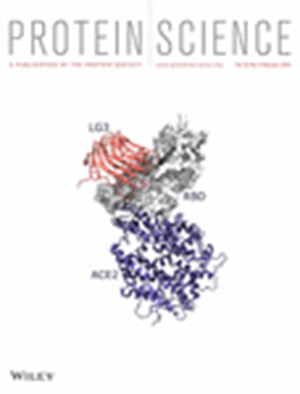Inhibitor binding and disruption of coupled motions in MmpL3 protein: Unraveling the mechanism of trehalose monomycolate transport
IF 4.5
3区 生物学
Q1 BIOCHEMISTRY & MOLECULAR BIOLOGY
引用次数: 0
Abstract
Mycobacterial membrane protein Large 3 (MmpL3) ofMmpL3 蛋白中的抑制剂结合和耦合运动破坏:揭示三卤糖单霉素转运机制
结核分枝杆菌(Mtb)的分枝杆菌膜蛋白大 3(MmpL3)对于单巯基三卤糖苷(TMM)在细菌细胞内膜上的转运至关重要,这使它成为抗结核(TB)药物开发的一个有希望的靶点。虽然一些结构、微生物学和体外研究提供了重要的见解,但 MmpL3 转运 TMM 及其抑制作用的精确机制在原子水平上仍不完全清楚。本研究对Mtb MmpL3的apo形式和七种抑制剂结合形式进行了分子动力学(MD)模拟,以全面了解该蛋白质的动力学和功能。MD 模拟显示,本研究中的七种抑制剂都能稳定地结合到跨膜结构域的中央通道,并主要与 ASP251、ASP640 或这两个残基形成氢键。通过动态交叉相关矩阵和主成分分析分析,在apo状态下观察到了不同结构域之间的几种耦合运动,并利用马尔可夫状态模型分析确定了不同的构象状态。这些耦合运动和不同的构象状态可能有助于 TMM 的运输。然而,对抑制剂结合的 MmpL3 进行的模拟显示,质子通道扩大,可能会破坏耦合运动。这表明抑制剂可能通过直接阻断质子通道来损害 MmpL3 的转运功能,从而阻碍结构域的协调运动并间接影响 TMM 的转运。
本文章由计算机程序翻译,如有差异,请以英文原文为准。
求助全文
约1分钟内获得全文
求助全文
来源期刊

Protein Science
生物-生化与分子生物学
CiteScore
12.40
自引率
1.20%
发文量
246
审稿时长
1 months
期刊介绍:
Protein Science, the flagship journal of The Protein Society, is a publication that focuses on advancing fundamental knowledge in the field of protein molecules. The journal welcomes original reports and review articles that contribute to our understanding of protein function, structure, folding, design, and evolution.
Additionally, Protein Science encourages papers that explore the applications of protein science in various areas such as therapeutics, protein-based biomaterials, bionanotechnology, synthetic biology, and bioelectronics.
The journal accepts manuscript submissions in any suitable format for review, with the requirement of converting the manuscript to journal-style format only upon acceptance for publication.
Protein Science is indexed and abstracted in numerous databases, including the Agricultural & Environmental Science Database (ProQuest), Biological Science Database (ProQuest), CAS: Chemical Abstracts Service (ACS), Embase (Elsevier), Health & Medical Collection (ProQuest), Health Research Premium Collection (ProQuest), Materials Science & Engineering Database (ProQuest), MEDLINE/PubMed (NLM), Natural Science Collection (ProQuest), and SciTech Premium Collection (ProQuest).
 求助内容:
求助内容: 应助结果提醒方式:
应助结果提醒方式:


